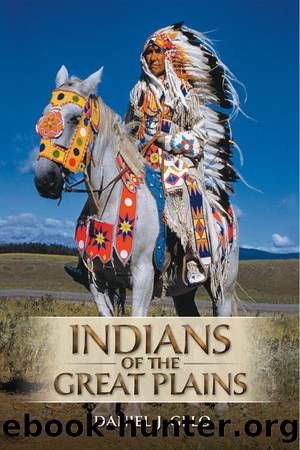Indians of the Great Plains by Gelo Daniel J.;

Author:Gelo, Daniel J.;
Language: eng
Format: epub
ISBN: 4758193
Publisher: Routledge
POWER
Regardless of whatever ritualists, ceremonies, or spiritual beings might be present in one tribal tradition or another, all Plains Indian religion is formed around one fundamental concept, that of power. “Power” is the English word used by Indians and non-Indians to refer to a phenomenon that is recognized in all Native languages. Algonquian speakers such as the Plains Crees and Cheyennes refer to it as manitou. The Numic-speaking Comanches and Shoshones call it puha, and the Kiowas say d]y (also written dα-e; pronounced doy or dawe). For the Pawnees, the term is kawaharu. The word is baaxpée among the Crows and xupā for the linguistically related Hidatsas. The term among the Lakotas is wowaš’ake.
Another common English gloss of all these terms is “medicine.” The term appears in phrases such as “medicine man” and “making medicine.” While this usage is also found among Indians, they do distinguish between medicine as power and as substance—tonic, salve, or herbal remedy—and have native-language words that keep this distinction. For instance, Comanches say puha when referring to power but natsu for medicinal substance, though they may use the English word “medicine” for either. Lakotas distinguish between wowaš’ake, power, and pejuta, medicinal substance, a word derived from the terms for “grass” and “root.”
An initially helpful take on supernatural power is available by consulting the general scholarly literature on the subject. The power concept appears in cultures well beyond those of Native North America, and there is a longstanding practice of discussing it. One important synthesis was written by Durkheim, who compared power concepts found among natives of North America, Australia, and the South Pacific islands. Anthropologists came to use the Polynesian word mana as the generic term. Mana is defined as a supernatural or sacred force—outside of normal, everyday experience—and impersonal. It is likened to electricity, as a kind of energy which is itself invisible but evident from its effects, and which can flow from one location to another, dwell or be stored in variable amounts, and tapped. It can help or harm people.
In contrast to the prevalence of scholarly discussions, there are virtually no direct descriptions or analyses of power from Native Americans themselves. Their theories about power and its properties are instead evident only indirectly from myth and ritual, that is, from stories about humans and other beings acquiring and using power, and from their procedures for obtaining and manipulating it. From these sources of information, it is apparent that supernatural power has the attributes of energy that Durkheim and other scholars have identified. But rather than dwelling on the characteristics of power itself, Native discussions and activities are more likely to emphasize the conditions that are apparent when a being is receptive to power or possesses it.
The Lakotas go so far as to separate the idea of power (wowas’ake) from the condition of powerfulness and to emphasize the latter, terming the condition wakan. This condition is abstract and involved, though not impossible to explain or understand. A description by the Lakota George Sword circa 1908 provides a good start:
Wakan means very many things.
Download
This site does not store any files on its server. We only index and link to content provided by other sites. Please contact the content providers to delete copyright contents if any and email us, we'll remove relevant links or contents immediately.
| Africa | Americas |
| Arctic & Antarctica | Asia |
| Australia & Oceania | Europe |
| Middle East | Russia |
| United States | World |
| Ancient Civilizations | Military |
| Historical Study & Educational Resources |
1787 by Nick Brodie(1149)
The 2012 Story by John Major Jenkins(1007)
Bury My Heart at Wounded Knee by Dee Brown(990)
Witchcraft in Early North America by Alison Games(862)
Plagues and Peoples by William H. McNeill(860)
Native American Folklore & Traditions by Elsie Clews Parson(827)
Ada BlackJack by Jennifer Niven(820)
Empire of the Summer Moon by S. C. Gwynne(780)
0735220891 by Craig Johnson(777)
Tending the Wild by Anderson M. Kat(772)
The Wisdom of the Native Americans by Kent Nerburn(755)
They Called Me Number One by Bev Sellars(746)
The Truth About Stories by Thomas King(712)
The Killing of Crazy Horse by Thomas Powers(707)
American Serengeti by Dan Flores(697)
An Inca Account of the Conquest of Peru by Ralph Bauer(691)
House of Rain by Craig Childs(672)
Sand Talk by Tyson Yunkaporta(662)
Unworthy Republic by Claudio Saunt(624)
